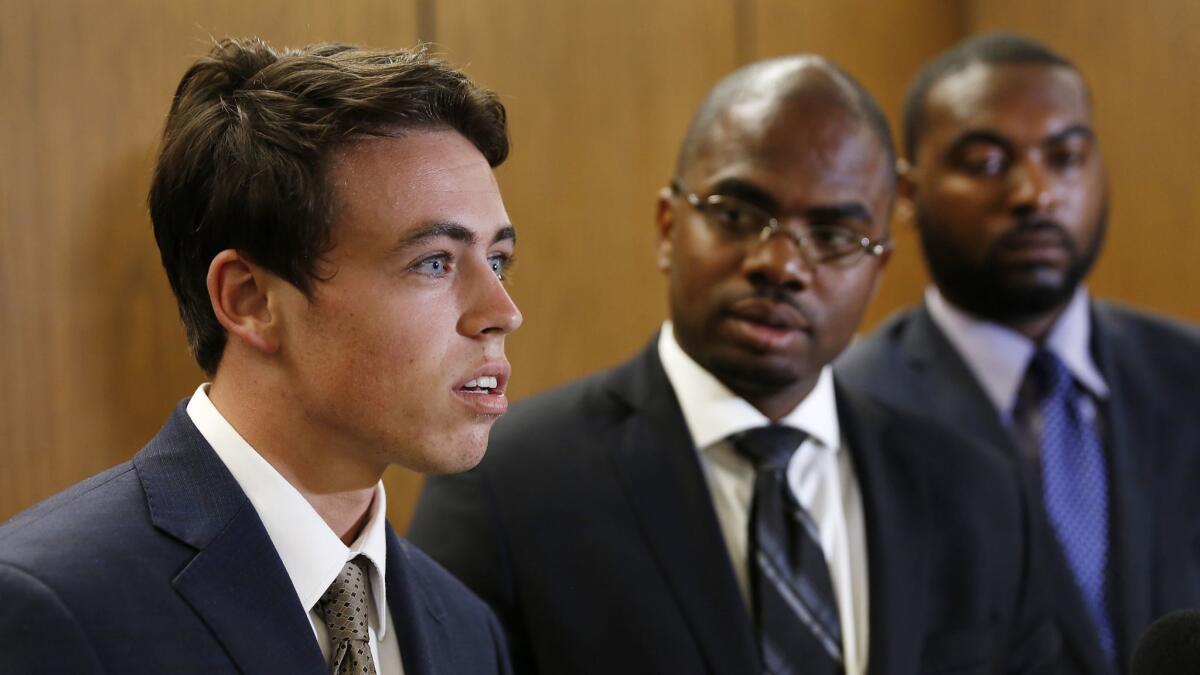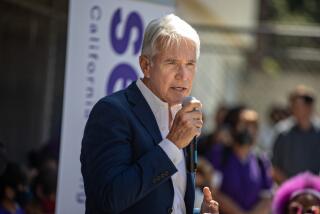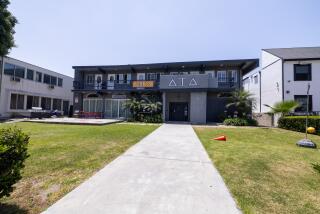Must Reads: A wealthy teen was cleared in a South L.A. killing. Critics say his race and privilege helped him win

- Share via
The case was unique from the start: A white, blue-eyed teenager from the affluent Los Angeles suburb of Palos Verdes Estates was arrested in October on suspicion of murder in an alleged gang killing in South Los Angeles. About a week later, Cameron Terrell posted $5-million bail, grabbing headlines.
He was in the spotlight again in July, after a jury found Terrell — the driver in the shooting — not guilty of murder and two counts of attempted murder in the death of 21-year-old Justin Holmes.
Terrell, 18, admitted he was the driver. The black Mercedes Benz, registered to his father, was caught on surveillance video. The central question posed to the jurors during the two-week trial was what Terrell knew and when.
“Cameron didn’t expect to hear gunshots,” his attorney, Jovan Blacknell, told the jury. “He didn’t expect any of this to happen.”
After the verdict was read, Deputy Dist. Atty. Tricia Taylor sat still at the attorney’s table in the courtroom and looked straight ahead. The family of the victim shook their heads as they walked out of the room, shepherded by a deputy.
Some saw the acquittal as yet another example of a criminal justice system that hands out unequal punishment based on race, ethnicity and wealth.
On social media, comparisons were made to Brock Turner, the Stanford University freshman who was sentenced to six months in jail for three counts of sexual assault, a sentence many found too lenient. People tweeted that Terrell got away with murder, while many other black men and youth are in prison for the same crime.
Others dismissed those suggestions, asserting that prosecutors overreached and focused too much on establishing Terrell’s alleged gang membership without proving he committed the crime.
Blacknell argued the latter but acknowledged the subtle racial dynamics at play.
“He wasn’t set free because he was white,” said the attorney, who is black. “But I do think that the jurors gave him the benefit of the doubt. I don’t think all minorities get that.”
Jody Armour, a law professor at USC, said studies have shown that black people are viewed more unsparingly than whites for the same crime.
Armour said that a white “wrongdoer” is often thought to be influenced by extenuating circumstances rather than being a bad person.
“Jurors judge black hearts more harshly than similarly situated white hearts,” he said.
Another advantage was that Terrell’s family was able to post the $5-million bond, which required $500,000 in cash. During the trial, Terrell was able to go home each night. During breaks, dressed in a navy suit, he would sometimes walk in Grand Park and meet his lawyers at the nearby law library. Jurors could see him in the halls waiting to enter the courtroom or cafeteria.
“It’s such a tremendous benefit to be out of custody,” Blacknell said. “He’s not just who they’re talking about in a vacuum in a courtroom — he’s also this guy, this kid who we see walking around like a regular person.”
Terrell also had the privilege of hiring a private defense attorney, rather than being assigned a public defender, said Richard Kania, a criminal justice professor at Jacksonville State University. His youthful, clean-cut appearance also helped.
“He just doesn’t fit the image of a gangbanger,” Kania said.
Prosecutors alleged that Terrell was a member of the Rollin’ 90s Neighborhood Crips. On Oct. 1, they said, Terrell and two other gang members drove to the 7800 block of South Western Avenue to target rivals. The two teenagers with Terrell got out of the car, walked up to Justin Holmes and two others and asked about their gang affiliation, prosecutors said. The others ran, but Holmes said he wasn’t from a gang. One of the juveniles shot Holmes, then ran to Terrell’s waiting car.
“They didn’t even see this coming,” Taylor, one of the trial prosecutors, said of the victims. Holmes and his friends were not gang members, she said. Holmes worked for U-Haul and was enjoying a weekend off work. His family declined to comment for this story.
During the trial, Blacknell told the jury that Terrell is an only child whose parents were having “issues” at home when the teenager began hanging out at the gang’s stomping ground, Jesse Owens Park in South Los Angeles. There, Terrell met another teenager who would later join the Crips set. To his new friends, Terrell was “a complete stereotype,” Blacknell said in court.
“He was a wealthy white kid who drove a Mercedes Benz,” he said.
Terrell was so fascinated with gang culture that he purchased a book on understanding gangs. He kept good grades, and found that his “trivial problems” didn’t compare to what the kids in South Los Angeles were going through, Blacknell told the jury during opening statements.
Prosecutors tried to convince the jury that despite Terrell’s background, he was fully committed to the Rollin’ 90s Neighborhood Crips and got a tattoo with a “W” symbol that represented the gang. Although Terrell didn’t pull the trigger in the shooting, prosecutors argued that when the group went to the rival neighborhood, he knew the teens were armed and likely looking for people to shoot. A large chunk of the trial focused on Terrell’s social media accounts and videos that showed him throwing gang signs and flashing weapons.
“They came in the middle of the day to kill somebody and they didn’t care,” Deputy Dist. Atty. Adan Montalban told the jury during opening statements. Montalban played a video taken from Terrell’s phone the night of the murder, showing him in what appears to be a bathroom, throwing gang signs.
“He went home that evening and he lets everyone know how proud he is,” he said. “Murder is the extreme crime that you can show that you’re down with the gang.”
Josh Ritter, a former L.A. County prosecutor who is now a defense attorney, said he rejects the notion that Terrell walked because he was white, but said the verdict reflected the complexities of the case: Sometimes charging a person with murder who isn’t the actual shooter is hard for jurors to “wrap their heads around.”
“You just never can tell which way a jury can go,” he said. That element, combined with Terrell’s background, could have made the case difficult for jurors.
Alex Alonso, a legal consultant who sometimes testifies on behalf of defense attorneys in gang cases but did not in this case, said he wasn’t surprised at the outcome of the trial.
“It’s a knee-jerk reaction for the public to assume that white privilege had something to do with it,” Alonso said. Instead, Alonso said he thought the prosecution bungled the case by overcharging Terrell and failing to prove he was part of the murder conspiracy.
Alonso said that he has seen similar cases end up in acquittals, citing the 2014 death of Patricia Alfaro, 17, who was killed in a car-to-car shooting at a South Los Angeles intersection. Semaj Welch, 22, who was driving the other vehicle but was not the gunman, was found not guilty. Welch is black.
Lawrence Bowie, the father of one of the two 17-year-old juvenile defendants charged in the death of Holmes, said he thinks Terrell got off “scot-free” because he’s white. Bowie remembers when Terrell started showing up in the neighborhood and at Jesse Owens Park down the street.
“Who is this?” he thought. “How did he end up over here?”
Bowie said he has gotten threats from neighbors he thinks are associated with the case. His son has been incarcerated in juvenile detention since October, trying to reckon with what he’s been through. Bowie said that his son was traumatized after the deaths of his sister and niece in a 2015 fire that ripped through their Inglewood apartment complex. He suggested his son might have been taken advantage of by Terrell.
He still wonders why Terrell wanted to be in the area in the first place, rather than his neighborhood 20 miles away.
“We got dreams of being like that,” he said. “We didn’t have that many opportunities, and you did.”
Terrell graduated from high school while his case was pending (he stopped attending Palos Verdes High School after parents protested and finished his studies off-campus). He’s attending the University of Houston, and trying to “get back to living his life as much as he can,” Blacknell said. His family, through Blacknell, declined to comment for this story.
Blacknell said he received backlash from the black community for the perception that he helped a white man get something that a black or Latino client might not get.
“The answer to their problem isn’t for the system to treat Cameron wrong,” he said. “It should be for the system to treat Latino and minority clients better.”
The Homicide Report: Every homicide in Los Angeles County since 2000 »
For more crime news, follow @nicolesantacruz on Twitter.
More to Read
Sign up for Essential California
The most important California stories and recommendations in your inbox every morning.
You may occasionally receive promotional content from the Los Angeles Times.











